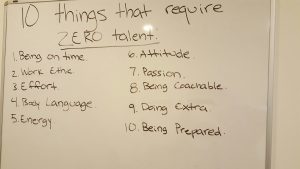Molly Fletcher's Blog, page 15
December 6, 2016
What the Jerry Maguire Manifesto Teaches Us About Purpose
 The 20th anniversary (yes, that’s not a typo!) of the movie “Jerry Maguire” is this week. Based on real characters in pro sports, this famous romantic comedy gave audiences a glimpse behind the curtain of the sports agent business.
The 20th anniversary (yes, that’s not a typo!) of the movie “Jerry Maguire” is this week. Based on real characters in pro sports, this famous romantic comedy gave audiences a glimpse behind the curtain of the sports agent business.
For me, the movie brings me back to where I was in 1996 when it was released, just beginning my career in the sports industry. It wasn’t until a few years later that CNN referred to me during an interview as “the female Jerry Maguire— a moniker that stuck and still invites curiosity to this day.
This anniversary inspires me to look back and compare real life to this movie one more time. There’s so much in it that inspires me and reflects what was going on early in my career then, and one of the most important lessons of success that is also in the movie.
(For a refresher on this classic movie, here’s a good link.)
What’s Your Manifesto?
The scene in which Jerry Maguire (played by Tom Cruise) pens a heartfelt mission statement sets the stage for the entire movie. After experiencing a crisis of conscience, Maguire pens the memo and with a renewed sense of purpose, distributes it to the entire company thinking it will have a similar impact on those around him. Spoiler alert: it doesn’t. Instead, Jerry Maguire gets fired and thus embarks on a journey to rebuild what he once had while learning hard truths along the way.
Earlier this year, we got more insight when the movie’s director Cameron Crowe released the full 25-page manifesto that Jerry Maguire wrote, titled: “The Things We Think and Do Not Say.”
The memo details Maguire’s thought process and values. Even though he’s fictional, he accurately describes the win-at-all-cost competitiveness as it relates to sports representation very well. This movie grabs us through Jerry’s search for himself and the meaning of success in the middle of all the jockeying.
That’s why I love his line, “Let’s bring soul and character to what is already there.” As we keep doing what we do well, let’s never forget our humanity. Values like honesty and integrity serve as our filters and our anchors.
What would your manifesto say? What are the things you think, yet do not say? What are the values that you hold deeply, and are you in a place where they align with your work? If not, you may need to reinvent yourself!
Stop sleepwalking
Even if you don’t have time to read the entire manifesto, the last four paragraphs are so worthwhile. Because even if your work reflects your values, you often need to check for adjustments. Even if you are super mindful, the pace of work and distractions constantly pull us away from what really matters to us. It’s easy to mistake achievement for fulfillment and find ourselves drifting from our purpose.
Whatever you do, pay attention. That’s what the Maguire manifesto emphasizes, and I completely agree.
Avoid “the feeling of sleepwalking. Of others living life around you, keeping their fists tightly wound around whatever dollars they can muster, caring little more than nothing about those around you,” Maguire writes. “We cannot sleepwalk. We cannot just survive, anything goes. We can take control of our lives, we can quit sleepwalking, we can say — right now, these are our lives, it is time to start living it. A life isn’t worth living if you are sleepwalking through it.”
If we are truly awake and alive to our personal mission statement, we no longer go through the motions.
The final line in the Maguire Manifesto really nails what everything is about, in a direct piece of wisdom gained from his years of experience: “The secret to this job is personal relationships.”
None of us exist in a vacuum or bubble. As exciting as our goals may be, our best experience is not the attainment of those aspirations. It is the journey and the people along the way that give us meaning.
Your Game Changer Takeaway
Hopefully this blog had you at hello. I hope you’ll be inspired to reflect on how much of your life is about “show me the money”—and how much is about the people who complete you. How will you connect to your mission today and every day?
Molly Fletcher helps inspire and equip game changers to dream, live and grow fearlessly. A keynote speaker and author , Molly draws on her decades of experiences working with elite athletes and coaches as a sports agent, and applies them to the business world. Her e-learning courses spark both personal growth for individuals and corporate development for organizations. Sign up here to receive our monthly newsletter.
The post What the Jerry Maguire Manifesto Teaches Us About Purpose appeared first on Molly Fletcher.
November 29, 2016
8 Ways To Boost Team Morale
 If your team or a team member is suffering from low morale, productivity suffers for everyone involved. Maybe it’s a lingering issue or related to a specific event, but whatever the reasoning, low morale impacts productivity and isn’t sustainable (not to mention not fun). It doesn’t have to be that way! Today, you can and should take immediate action to boost your team’s spirits.
If your team or a team member is suffering from low morale, productivity suffers for everyone involved. Maybe it’s a lingering issue or related to a specific event, but whatever the reasoning, low morale impacts productivity and isn’t sustainable (not to mention not fun). It doesn’t have to be that way! Today, you can and should take immediate action to boost your team’s spirits.
When you acknowledge and appreciate the people around you, you are demonstrating a mindset of service. I believe every team member and leader needs to have this top of mind. Never let yourself be satisfied with the autopilot mentality or the status quo.
Today, if you’re in one of those valleys where morale isn’t great, commit to one of these steps.
Why wait?
Molly’s Favorite Morale Boosters
1. Respectively seek out your team member’s space to check in. There’s no substitute for face time and being present, and positive body language can convey that you care. Meeting a team member in their space signals that you care.
2. Remind each team member of his/her particular strengths. Give a recent concrete example. Celebrating the differences that make your team strong helps everyone express their individuality and embrace their unique gifts.
3. Offer authentic gratitude to your teammate. Don’t forget the simple power of saying thank you. Acknowledging the little “thankless tasks” along the way that are beneficial to your team’s collective well-being can go a long way in showing people that they are valued.
4. Extend a helping hand. Even if your team member declines, sometimes this gesture is the best way to acknowledge the challenges a person is facing.
5. Break the routine. If your team has been grinding, can you build in some time off? Maybe it’s a gorgeous fall day in your area and it’s time to encourage some fresh air and rejuvenation. An impromptu team lunch or happy hour might really help everyone.
6. Encourage team members to share something that has helped them lately. You can model this by sharing something that speaks to your team’s challenges and encourages them. Maybe a quote that is genuinely inspiring to you and the reason why, or a book.
7. Inject humor if possible. This can be a little tricky and should not be at the expense of anyone. Done right, it reflects your perspective and the ability to step away from a situation long enough to see it in a different way. Humor keeps us from taking tasks so seriously that the tasks get harder to complete.
8. Eliminate distractions and unnecessary structure that kill morale. Is there something people dread that you can remove from their world for a period of time? Structure that is supportive and clear is much more effective for focusing team members. It bears in mind the best interests of each team member, builds trust and encourages balance.
Your Game Changer Takeaway
Choose one action item to implement with your team today. Or maybe you’re inspired to do something more customized for your team.
When you compassionately serve those whose work with you, you set an example for selflessness that guides a team to better morale. Model the behavior that shows that their efforts are valued—and do it now and often.
Molly Fletcher helps inspire and equip game changers to dream, live and grow fearlessly. A keynote speaker and author , Molly draws on her decades of experiences working with elite athletes and coaches as a sports agent, and applies them to the business world. Her e-learning courses spark both personal growth for individuals and corporate development for organizations. Sign up here to receive our monthly newsletter.
The post 8 Ways To Boost Team Morale appeared first on Molly Fletcher.
November 16, 2016
Intentional Gratitude: It’s Not Just for Thanksgiving
 Thankfulness is such a great way to pivot toward what matters. We think about it a lot during this time of year, but I’d like to challenge you (and me too) to make intentional gratitude part of your day all year.
Thankfulness is such a great way to pivot toward what matters. We think about it a lot during this time of year, but I’d like to challenge you (and me too) to make intentional gratitude part of your day all year.
In addition to a bucket list of things to do or places to go one day, let’s also make make a list of people we want to show gratitude toward all year. People we want to appreciate more consistently.
Do this, and you’ll find you are happier, more fulfilled and connected to the things and people that matter most in your life. There are so many benefits. Sounds good right?
It’s simple: Stop a few times a day, scan what you are experiencing internally and outside yourself, and connect to what you are grateful for. Through a daily practice of gratitude, here are some ways we benefit.
1. Closer ties to people who are most important to us. By telling them specifically that we are thankful for them and what they mean to us, they know that their existence matters regardless of what they do for us or vice versa. Gratitude affirms.
2. Greater warmth with people whom we come across in our daily lives. “Try leaving a trail of little sparks of gratitude on your daily trips,” Dale Carnegie said. “You will be surprised how they will set small flames of friendship that will be rose beacons (a torch of honor) on your next visit.” Gratitude inspires.
3. More awareness in general. Keep a gratitude journal and you will begin to seek positives as part of your daily life. Gratitude nurtures mindfulness.
4. More opportunities to practice empathy. Thankfulness gets you out of the me-first attitude. Without that big obstacle, you have the opportunity to see possible next steps of making a difference to others. On my radar: a close friend who was just diagnosed with cancer, a neighbor in the same boat, and a new family who just moved in nearby. Gratitude leads to meaningful service.
5. A mirror on what matters to you. Gratitude reveals our values through how we choose what to be thankful for. These values speak to your purpose. Gratitude grounds us.
Your Game Changer Takeaway
Thanksgiving is a great time to start a new tradition, so why not make a daily habit of intentional gratitude that will spark immediate positive change in your world today?
Molly Fletcher helps inspire and equip game changers to dream, live and grow fearlessly. A keynote speaker and author , Molly draws on her decades of experiences working with elite athletes and coaches as a sports agent, and applies them to the business world. Her e-learning courses spark both personal growth for individuals and corporate development for organizations. Sign up here to receive our monthly newsletter.
The post Intentional Gratitude: It’s Not Just for Thanksgiving appeared first on Molly Fletcher.
November 14, 2016
Don’t Let High Expectations Ruin Your Team’s Motivation
 Great sports teams—and industry leaders—must learn to cope with high expectations. If you don’t, this pressure can cause fear to ruin your team’s motivation.
Great sports teams—and industry leaders—must learn to cope with high expectations. If you don’t, this pressure can cause fear to ruin your team’s motivation.
We set high expectations on the basis of past success (we are at the top or near, and we want to stay there) or aspiration (we want to be at the top). Sometimes there’s even a chip on the shoulder (we should be at the top).
High expectations can come from inside our team …. From outsiders … or both. We carry them individually and as a group. This is true in business, sports and other arenas. For high achievers, high expectations come with the territory.
Sports fans, think about the Golden State Warriors for example. With two superstars on their roster, the Warriors are pegged as a possible “superteam” for the ages. (Las Vegas even made this team an odds-on favorite to win the NBA title. “Odds-on” means a team has a better than even chance to win—you win less money than you bet. It’s extremely rare.)
I for one am watching to see how they handle this, because I know that a team’s success depends on managing its talent and expectations. High expectations crush motivation when we think there is no safety net for failure. “There’s no where to go but down,” becomes the thinking.
Fear creeps in when high expectations remove any sort of safety net. The bar that has been set and anything below that is failure.
High expectations can exhaust your team. So how do you sustain what makes your team perform well?
A Fearless Mindset
The key to managing high expectations is approaching your goal with a fearless mindset. A purpose statement is so effective for this because a clear, concise statement of what matters to you and what drives you.
Here is what the purpose statement does to counter high expectations.
Your purpose exists outside of the numbers by which others judge you.
Your purpose helps internalize that factors outside your control (wins, losses, sales figures, etc.) do not define you.
Your purpose goes beyond pleasing those that you don’t know.
Your purpose is a compass for your time and energy, protecting your finite resources.
Your purpose guides you away from distractions and the noise. You can concentrate better.
Your purpose is a stake in your values apart from what others say or think.
In my experience working with team building, and as an agent to high-performing athletes, coaches and broadcasters, I noticed the power of purpose.
No matter how heavy the expectations, a high achiever who was clear on purpose was much more likely to stay humble and curious, to avoid defensiveness and fear, and enjoy the journey.
Your Game Changer Takeaway
When the tyranny of high expectations threatens your team, you can fearlessly respond when you are clear on your purpose. By focusing on fulfilling what makes your team distinctive, the purpose statement helps bulletproof your team from high expectations. Purpose makes high expectations work for your team.
Molly Fletcher helps inspire and equip game changers to dream, live and grow fearlessly. A keynote speaker and author , Molly draws on her decades of experiences working with elite athletes and coaches as a sports agent, and applies them to the business world. Her e-learning courses spark both personal growth for individuals and corporate development for organizations. S ign up here to receive our monthly newsletter.
The post Don’t Let High Expectations Ruin Your Team’s Motivation appeared first on Molly Fletcher.
November 7, 2016
How to Respond to Tough Feedback
 Defensive: It’s what we easily feel when we get tough feedback. In a flash, defensiveness (and anger, etc.) wall ourselves from words that sting. Even when the words are true.
Defensive: It’s what we easily feel when we get tough feedback. In a flash, defensiveness (and anger, etc.) wall ourselves from words that sting. Even when the words are true.
Recent research suggests that we drop people who give us critical feedback. Don’t miss out like this! Tough feedback can really help us. If we know how to respond with professionalism and poise, we gain an extraordinary tool for improvement and empowerment. Few of our peers and competitors can match this ability.
Let me describe how to put aside reactive feelings and benefit from tough feedback.
1. Stay open (verbally and nonverbally).
Your tone of voice and body language should be sincere and fluid, not rigid in any way. Take notes if that helps you focus and listen on what is being said, not what you are going to say next. Aim for a tone of humility and sincerity. Keep eye contact, project thoughtfulness and say thank you if you can. Think “gracious.” This step is first because new actions help cue new thinking, especially in stressful situations.
2. View your critic as a helpful challenger.
The challenger is one of four archetypes that you really need in your life. This is the person who will push you out of your comfort zone, even (or especially) when you have made up your mind. Tough feedback from the challenger forces you to think through things in a different way, which leads to better decisions. As you listen to the tough feedback, consider it as a challenge that may help you reach a bigger-picture goal. This step is a way to shift your perspective.
3. Lean into curiosity.
Tough feedback is a moment where you have a choice: feel attacked or embrace what you can get from it. “Tell me more about that…” is a good way to communicate curiosity and respect, because it signals that you are listening. This step deflects emotion on both sides and creates a common ground to work to a mutually beneficial outcome.
4. Fill in a mental picture of behavior change.
Drill down to find out as much as you can about what isn’t working. Details are essential to understanding the perception of what needs to change. “Do you have any specific examples you can give me?” is a great question for this. Don’t assume that you understand what the feedback is about; tough feedback isn’t vague feedback! This step ensures that you are aware, accurately, of what is being communicated.
5. Own your responsibilities
Tough feedback is a great chance to review your personal mission statement to see if you can be more effective. Examine the tough feedback in light of your commitments, and you will find that owning your responsibilities—and shortcomings—can be empowering. This step helps ground you in who you are—and offers an opportunity to reflect on who you want to be when you are at your best.
6. Create a game plan.
Asking, “How can we go forward together?” is an offer of a mutual way to solve the issue. Sometimes you need to pause between the feedback and this step, but it is the most concrete way of communicating that you have heard, valued and considered the tough feedback and you are willing to respond positively. A game plan grows from a holistic approach to tough feedback based on good intentions, integrity and calm. This step doesn’t mean you will cave in!
Your Game Changer Takeaway
Managing tough feedback is an excellent skill to practice because few people come to it naturally. When you first adopt these six steps, you may have to “fake it till you make it.” Keep going! You will become a rare leader who welcomes tough feedback as an opportunity for understanding your potential for growth and meaning in the work that only you can do.
Molly Fletcher helps inspire and equip game changers to dream, live and grow fearlessly. A keynote speaker and author , Molly draws on her decades of experiences working with elite athletes and coaches as a sports agent, and applies them to the business world. Her e-learning courses spark both personal growth for individuals and corporate development for organizations. S ign up here to receive our monthly newsletter.
The post How to Respond to Tough Feedback appeared first on Molly Fletcher.
October 31, 2016
How to Turn Around Your Struggling Team Now
 This year’s remarkable World Series match up shows us that it is possible to turn around your team. No matter how toxic the history, it is possible to let go of your team’s old story and embrace a new one.
This year’s remarkable World Series match up shows us that it is possible to turn around your team. No matter how toxic the history, it is possible to let go of your team’s old story and embrace a new one.
If you are coping with a team that needs a turnaround, study these important lessons from the Cleveland Indians and Chicago Cubs. Both struggled through decades of losing (the Indians last went to the World Series in 1948, the Cubs in 1908).
Here’s how your team can benefit from their example.
1. A turnaround team doubles down. The Indians succeeded despite the loss of their great outfielder to surgery, the rejection of a great catcher who refused to be traded to them, and injuries to two of their best players. “This team’s been resilient from the start,” general manager Mike Chernoff said. “Nobody built up the anxiety or built up the expectations. Guys just stepped in and took advantage of the opportunities.”
2. A turnaround team realizes that all teams face obstacles. Former Cub Doug Glanville points out that everyone deals with some kind of baggage, historical or otherwise: “Life and loss, yet still with a chance at rebirth, redemption, honor,” he says. “Our pain … has ripened, helping us all reinterpret the events that led to this point. History has been rewritten, or maybe we’ve just been patient enough to let history become our present.”
3. A turnaround team figures out how not to lose control. Bad things happen; but your team doesn’t have to make things worse. There’s even a stat for this in baseball, called cluster luck, which both teams were ranked above the median major league teams for their ability to cluster hits to score runs and to scatter opponents’ hits so they couldn’t score. (In pro football, this is called toxic differential; it measures a team’s ability to make big plays and keep their opponents from doing the same.)
4. A turnaround team believes in each other and themselves, and their belief anchors them in the present moment. “As soon as I came in, I felt the chemistry,” said Coco Crisp, who joined the Indians during the summer. “Everybody loves each other. It’s almost like a family. These guys grind and they believe they’re going to get it done.”
5. A turnaround team finds a common focus. For the Cubs, the rally cry was “Win the Inning!” It was all about respecting history but choosing to be in the present tense.
Your Game Changer Takeaway
A toxic history can make a team stuck in old habits. But it is possible to shift to a new story! These remarkable baseball teams overcame a combined 174 seasons of falling short to finally meet this year in the World Series. Can you adopt one of their go-to habits to start rewriting your story? I’m excited to hear how your team is making that shift. It’s everything!
Molly Fletcher helps inspire and equip game changers to dream, live and grow fearlessly. A keynote speaker and author , Molly draws on her decades of experiences working with elite athletes and coaches as a sports agent, and applies them to the business world. Her e-learning courses spark both personal growth for individuals and corporate development for organizations. S ign up here to receive our monthly newsletter.
The post How to Turn Around Your Struggling Team Now appeared first on Molly Fletcher.
October 25, 2016
How To Be Present—And Why It Matters
 “The greatest gift you can give somebody is your attention because your attention is your time, and your time is your life,” author Rick Warren says. “You’re never going to get it back, and that’s why it is so precious when you give it.”
“The greatest gift you can give somebody is your attention because your attention is your time, and your time is your life,” author Rick Warren says. “You’re never going to get it back, and that’s why it is so precious when you give it.”
We find meaning and closeness in recognizing each other’s important moments. And that’s pretty hard to do when our attention is somewhere else.
In the middle of our busy schedules, how can we lock in and be present? Here are four tips for how to be present in the relationships in your life that matter most.
1. Create at least one ritual that focuses your attention.
Maybe it could be leaving your phone off or face down to bring your focus to the person nearby. Or make your screen saver a reminder to be present with people, not technology.
My daughter Kate, an early riser, knows that she has her mom all to herself in those first moments of the day because that’s our ritual. I signal to her that I’m truly present by closing my laptop screen when she comes downstairs. The emails can wait, and the simple gesture sends her the message that she is my priority and that I value our morning time together above anything else.
2. Prioritize face time.
Listen with your eyes, not just your ears. Make eye contact and give feedback. Take notes if appropriate. Reflect on a time when you felt truly heard—how did the listener communicate that? Can you begin practicing that habit?
3. Recognize important moments.
When a family member, client or someone significant to you shares an event that has great meaning to them, make a note to recognize that. Great relationships, like major personal achievements, result from consistently recognizing and appreciating the power of small moments.
I learned this as a sports agent when I recruited major league baseball player Mark DeRosa partly by understanding his important moment: a celebration at his high school when his football jersey got retired and he was playing pro baseball (he had been drafted by teams in both pro sports).
4. “Be where your feet are.”
These are the words of Alabama football coach Nick Saban, who credits his teams’ long tradition of success with the ability to lock in and be present, focusing on what they can control.
I vividly remember learning I was pregnant with twins shortly after the birth of my first daughter. It was such an emotional moment and such big news to take in, but I had a meeting in 30 minutes with a coach I represented at the time as his agent. He was going through some big changes of his own, so for that next hour, he was my priority. I needed to show up and be present in that meeting, no matter how distracted I may have been just minutes before. I re-focused and for the next hour was intentional about staying present in the moment.
Your Game Changer Takeaway
You can’t fake attention. You can’t simply talk about doing it. You have to give it consistently and authentically if you want to build great relationships. What ritual or new behavior can you start today to direct your attention to the people who matter most to you? It may be the greatest gift you can give them.
Molly Fletcher helps inspire and equip game changers to dream, live and grow fearlessly. A keynote speaker and author, Molly draws on her decades of experiences working with elite athletes and coaches as a sports agent, and applies them to the business world. Her e-learning courses spark both personal growth for individuals and corporate development for organizations. Sign up here to receive our monthly newsletter.
The post How To Be Present—And Why It Matters appeared first on Molly Fletcher.
October 17, 2016
The Myth of Bringing Your Whole Self to Work
 The pro golfers that I represented as a sports agent had a difficult challenge. Because their work took them on the road, sometimes for weeks at a time, their family time suffered. Some players chose to bring their families with them on the road, and that sometimes compromised their sleep and concentration. Some traveled solo and missed their family.
The pro golfers that I represented as a sports agent had a difficult challenge. Because their work took them on the road, sometimes for weeks at a time, their family time suffered. Some players chose to bring their families with them on the road, and that sometimes compromised their sleep and concentration. Some traveled solo and missed their family.
There wasn’t one right choice. Each player had to find his or her sweet spot.
Balance between work and home is so important, isn’t it? That’s why it’s important to challenge the idea of bringing “your whole self to work.” A better idea is bringing your best self to work.
This is especially important for leaders and parents, because you are modeling behavior that will influence others.
Balance means that you’re not burned out at home or at work. Your home and work situations fuel positive energy. Tough right? I agree.
I like this definition from the Johnson & Johnson Human Performance Institute: You are physically energized, emotionally connected, mentally focused, and completely aligned with whatever mission is most important to you.
4 tools for finding that balance
1. Develop a personal mission statement. This is your road map to achieve what is most important to you, and help filter the distractions. For example, my personal mission statement is to connect, inspire and lead with creative courage and optimism. I find it to be a bumper pad on my conversations, decisions, thoughts and, in turn, choices. We make mission statements at companies, why not for ourselves?
2. Notice your activity and energy output. Where do you spend the most time and energy? Is it aligned with your mission? As you mindfully inventory your time and energy output, ask yourself, “Is this serving my best self? Is this consistent with my personal mission?”
3. Dig into what fuels your best self at work. Certain habits will energize your best self at work (and certain ones don’t). For me, it’s a daily workout that clears my mind and makes me feel fresh and energetic to honor the needs of my schedule. Conversations with my family and feeling connected to each of them also energize me to show up as my best self. What in your life energizes you in the role you are playing at work?
4. Brainstorm what would make that balance even better. Here’s a tip I picked up from HPI: You likely spend more time working than doing anything else in your life, so it’s important to drill down on how your job could make you a stronger person. How could you ensure your job helps you become your best self and a better person
Your Game Changer Takeaway
When we find balance, we can be our best at home, in our roles with the people who are most important to us. That feeds our best work, and vice versa. No one size fits all. Use these tools to help challenge the myth of bringing your whole self to work. It’s more strategic and meaningful to devote your best self to your personal mission and the balance of work and home.
Molly Fletcher competed for Michigan State’s women’s tennis team and is raising three daughters who play sports. She works to inspire and equip game changers to dream, live and grow fearlessly.A keynote speaker and author, Molly draws on her decades of experiences working with elite athletes and coaches as a sports agent, and applies them to the business world. Her e-learning courses spark both personal growth for individuals and corporate development for organizations. Sign up here to receive our monthly newsletter.
The post The Myth of Bringing Your Whole Self to Work appeared first on Molly Fletcher.
October 10, 2016
Close but No Cigar? 5 Strategies to Recover from Disappointment
 We all deal with challenges, failures and disappointments at some point, and these five tactics can immediately help you recover better and faster. You’ll come out with fewer bruises and be on your way to regaining your confidence.
We all deal with challenges, failures and disappointments at some point, and these five tactics can immediately help you recover better and faster. You’ll come out with fewer bruises and be on your way to regaining your confidence.
1. Quickly break down the game film. Immediately pause from any urge to beat yourself up. With as little emotion as possible, thoughtfully analyze your near miss. Ask yourself what could I have done differently? How could I have done it differently? What was my role in it? How do I ensure I don’t repeat the same mistakes next time? Questions like these help you plan what you will do differently next time (see No. 3).
2. Ask a trusted friend or teammate for their perspective. Find a good listener and supporter who holds you accountable. Ideally this person is someone with no agenda who wants you to be your best. Immediately after disappointment, a friend like this can help reset your compass.
3. Assign yourself an action that will prepare you for success. Program this action into your calendar reminders to give yourself a focus on the future possibilities and let go of what is in the past. Is there a morning or evening ritual that will help prepare you for success?
4. Dip into your confidence toolbox. This is what I call a collection of techniques to keep up your spirits and belief in yourself at its healthiest level. Referencing your confidence toolbox immediately after a “failure” can be incredibly empowering and help you move forward.
5. Share what you learned. Disappointment and failure offer important lessons like resilience that can benefit others. At the ecommerce site Etsy, engineers send emails to coworkers after something went wrong and how it can be avoided next time. This quick action helps the company minimize blame and cover-ups.
Your Game Changer Takeaway
Disappointment is no fun, but in the immediate aftermath, you still have choices about how to deal with it. It’s important to separate your results from who you are and continue to pursue your personal mission with the knowledge gained from your near-miss.
What helps you rebound from disappointment? I would love to hear from you on social media and keep this important conversation going to benefit as many people as possible.
Molly Fletcher competed for Michigan State’s women’s tennis team and is raising three daughters who play sports. She works to inspire and equip game changers to dream, live and grow fearlessly.A keynote speaker and author, Molly draws on her decades of experiences working with elite athletes and coaches as a sports agent, and applies them to the business world. Her e-learning courses spark both personal growth for individuals and corporate development for organizations. Sign up here to receive our monthly newsletter.
The post Close but No Cigar? 5 Strategies to Recover from Disappointment appeared first on Molly Fletcher.
October 4, 2016
10 Things That Require ZERO Talent
 How often do we equate success with talent? All the time. But the reality is, success isn’t created by talent alone. Just like we might see immense talent squandered, we also see underdogs unexpectedly overachieve. Here are 10 behaviors that we can always control that require zero talent yet have a huge impact on our success.
How often do we equate success with talent? All the time. But the reality is, success isn’t created by talent alone. Just like we might see immense talent squandered, we also see underdogs unexpectedly overachieve. Here are 10 behaviors that we can always control that require zero talent yet have a huge impact on our success.
1. Being on time. Punctuality is a keystone habit that requires organization and planning ahead—both of which lead to greater success. Here’s a good primer on why being on time is important and how anyone can make it a habit.
2. Work ethic. This is the discipline of showing up consistently and making the best decisions that lead to peak performance. Even at the pinnacle of his career, basketball superstar Kobe Bryant’s work ethic was legendary. Kevin Durant recalls the message a veteran Kobe sent the younger players at Olympic Trials back in 2008, just after Durant’s first year in the league. The players were given a day off, but there was Kobe, the only veteran getting on the bus to go work out at a high school gym. “He made 50 shots at each spot around the 3-point line,” Durant recalls. “We just looked down there and said, man, he’s the best player in the league and he took a bus to a high school to get some work in. It’s that work ethic that Kobe embraced throughout his career to become one of the all-time greats. As Kobe said after getting drafted straight out of high school in 1996, “I don’t want (fans) to think I’m just a high school kid coming in here thinking the world owes me something. I’m going to go out there and I’m going to work.”
3. Effort. Few athletes worked as hard as major league pitcher John Smoltz, who is now in the Baseball Hall of Fame. As his agent, I saw him extend his career by years through sheer effort and commitment. He made up his mind to make changes along the way, like going from starter to closer, that kept him in the game as a valuable contributor to his team. Effort is a mindset as much as it is a behavior.
4. Body language. How you move and express yourself around others shapes who you are and how you are perceived. Anyone can improve, and here’s a TED talk that explains why and how.
5. Energy. Everyone has energy to devote to a goal, and the decision of how much to give. Be conscious about where yours goes.
6. Attitude. It’s up to you to keep going. No one else can decide that. A great attitude maximizes the talent that you do have and offsets what you lack.
7. Passion. Perhaps the single most important way each one of us can suffocate the fear that keeps us from peak performance.
8. Being coachable. Anyone can become a better listener, learn from feedback, and embrace the success of others.
9. Doing extra. Go the extra mile. I saw it all the time with the athletes I worked with. The ones who sustained their success were the ones who consistently worked at their craft beyond what was required. That extra work and preparation fosters confidence. We can all learn from this approach and exceed our own expectations.
10. Being prepared. Only you can give yourself the time and space to be as ready as you can be. Make it a habit, and you will make the most of your talent. There is great truth in the saying: Failing to prepare is preparing to fail.
Your Game Changer Takeaway
Remember that talent is never enough. The best of the best don’t rest on what they were born with—they dig down to get the most they can. Try these 10 things (or just one!) and over time it will pay off.
Molly Fletcher competed for Michigan State’s women’s tennis team and is raising three daughters who play sports. She works to inspire and equip game changers to dream, live and grow fearlessly.A keynote speaker and author, Molly draws on her decades of experiences working with elite athletes and coaches as a sports agent, and applies them to the business world. Her e-learning courses spark both personal growth for individuals and corporate development for organizations. Sign up here to receive our monthly newsletter.
The post 10 Things That Require ZERO Talent appeared first on Molly Fletcher.



